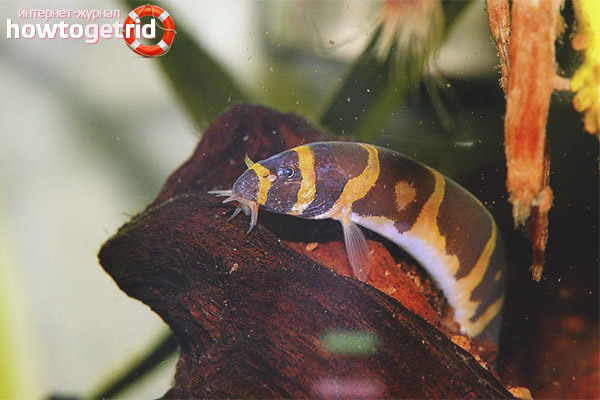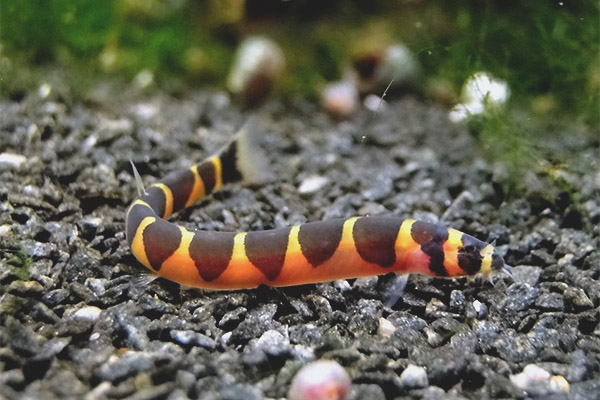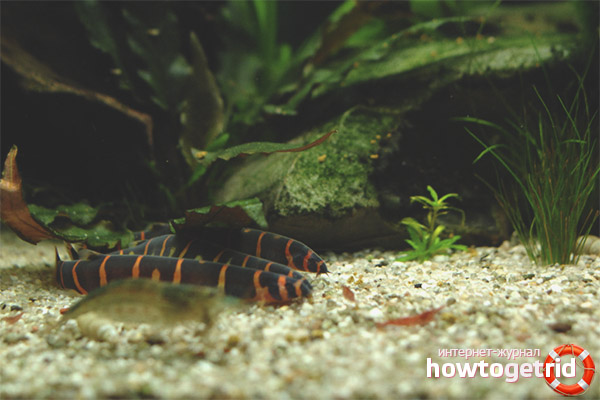The content of the article
Acantoftalmus is a species of aquarium fish belonging to the species of loaches. These individuals stand out among all the other loaches because they have an amazingly beautiful appearance. Representatives have a standard behavior for all reeds, they are mobile, constantly digging in the ground in search of food. This behavior is beneficial to all inhabitants of the aquarium, as acantophthalmos eats food debris that fell into the ground and became inaccessible to other species of fish. These pets maintain cleanliness in the aquarium, which also helps the owner.
About acantophthalmus, you can absolutely say that he is not a predator. It is necessary for this only to look at his mouth - very small, it is only suitable for digging in the soil material and searching for moths and other insects.
Acantoftalmuses are generally active at night. In the daytime, it is practically impossible to find with his eyes in an aquarium, especially if he lives there alone. However, if you spend a few minutes at the aquarium, you can still see the fish.
If several individuals of a different species live in the same aquarium, acanthophthalmuses begin to become active even during the daytime, since they begin to compete with other fish for food. Half a dozen akantoftalmusov will behave even more actively, however, these fish may well exist one at a time. Representatives of this species are quite hardy and can exist independently for a long time, without requiring the obligatory presence of other individuals.
Life in the wild
First of all, the description of this species of fish was compiled in 1846 by Valensis. In nature, they live mainly in South-East Asia, they can be found in Sumatra, Borneo, in Singapore, in Java and in Malaysia. These individuals are common, today they are not an exhibit of the Red Book, and therefore do not constitute protected value.
Akantoftalmus inhabits rivers, where there is a small low-speed current, as well as in mountain streams, the bottom of which is laid with fallen leaves. In such bodies of water, there are practically no rays of sunlight on the bottom, since there are trees along the edges of rivers and streams. Under natural conditions, these fish can be found in small groups, although they are not related to schooling species.
Description of the species
Akantoftalmus - a small fish, which in its form resembles worms. Such a fish grows up to 12 centimeters in length in nature; in a tank it can reach a maximum of 8 centimeters. Acantoftalmusy live quite a long time, the average life expectancy is 10 years, however, there are a large number of messages about much longer stays.
The color of this species of loach is pink-yellow with wide dark stripes, the number of which usually reaches a minimum of 12 and a maximum of 17 pieces. Acantophthalmos has three mustache pairs on the head. The dorsal fin is rather unusual compared to other species of fish, in the loach it is located near the anal one. Representatives of this species have an albino form, which was bred artificially, therefore, such individuals do not occur in nature.Since acanthophalmuses live mainly at night, their albinos die rather quickly, as they become more visible at the bottom than other individuals.
The main difficulties in the content

Akantoftalmus - simple, unpretentious and hardy variety of fish. The main difference between these loaches from other fish is the lack of scales on their body. This circumstance makes these individuals very sensitive to the effects of various therapeutic drugs. For this reason, any therapeutic measures in the aquarium should be carried out very carefully so as not to harm acantophthalmos.
These representatives of loachs are sensitive to water, therefore they prefer clean and well aerated water. For the maintenance of these fish requires regular water changes. In this case, with each substitution, it is extremely important to clean the soil, remove food residues and other waste from there. This is necessary because the wines, like many other fish, suffer most from ammonia and nitrates resulting from the breakdown of products.
How to feed acantophthalmos?
Acantoftalmusy - fish that eat almost everything. For this reason, they are easy to keep in the aquarium.
You can feed this type of loach at home with live and frozen food, as well as various flakes, granules, tablets and pellets. The main thing in the process of feeding is to ensure that the feed reaches the bottom of the aquarium so that other fish do not have time to eat it while it is in the water. If you take a live feed, then Acantophthalmos very much likes daphnia, bloodworms, Artemia, tubule and other insects. And even if these bloodworms or other insects dig in the soil at the bottom of the tank, acantoftalmus will quickly and easily find them. In this regard, representatives of this species are very useful, as when feeding other fish the food often falls to the bottom and remains there.
Content policy
In the daytime, acantophthalmos are mostly at the bottom, but at night they are actively swimming, and in all layers of water. The most suitable option for these fish are medium-sized aquariums, from about 70 liters by volume. The water should be soft enough, ph should be in the range of 5.5 to 6.5, while the light should remain moderate.Also in the aquarium must be a filter that will clean the water, mix it and create a small flow in the tank. The area of the bottom in the aquarium is of great importance for the life of acantophthalmos, and the volume of the tank is not so important in this case.
Decorative elements for aquarium can choose any at its discretion. Soil is better to carry out from small gravel or sand. Sand is ideal for akantoftalmusov, they can easily dig in it and sometimes even burrow completely. Caution should be placed in the aquarium large stones, because these fish they can periodically break in.
At the bottom you can additionally place snags with moss attached to them. This will be for them a reminder of the natural habitat conditions, as well as a reliable shelter for the rest. Acantoftalmusy - lovers hide in different elements inside the aquarium, so you need to organize for them the opportunity.
According to the behavior of acantophthalmos, one can predict changes in the weather. For example, if the fish behave restlessly and rush around the entire aquarium, periodically float or sink to the bottom, most likely, the weather will soon change significantly.If the weather is all right, but the pet still behaves restlessly, you should check the soil, it may have already sour, and the fish is disturbed by the released ammonia or hydrogen sulfide.
Akantoftalmusy able to escape from the aquarium, so the top of it must be something to cover, otherwise the fish may just crawl away.
Who can you settle with?
Acantophthalmos is well adjacent to shrimps, because it is rather slow compared to these nimble inhabitants, and it has a small mouth, thanks to which it will not destroy them. However, acantophthalmos can well swallow small shrimp, slightly gape.
It is not recommended to keep acantophthalmos and cichlids in one aquarium, as they can be food for the latter.Also should not be placed in the neighborhood of large and predatory fish.
Sexual signs
Distinguishing between females and males of akantoftalmus is quite easy. Females in representatives of this species are larger than males. Males can also be distinguished from females, because in the fin they have a thicker beam than those of females. However, this beam is often difficult to see, since the acanthophthalmuses are small and also quite secretive.
Video: akantoftalmus kylya aquarium fish












To send